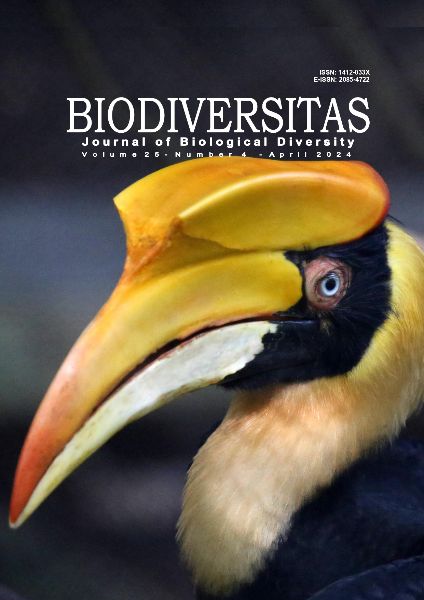Utilization of sago plants (Metroxylon spp.) as a bioindicator of water springs
##plugins.themes.bootstrap3.article.main##
Abstract
Abstract. Botanri S, Uluputty MR, Kamsurya M, Kamaruddin, Latuponu H, Habi ML, Djumat JL, Kaliky F. 2024. Utilization of sago plants (Metroxylon spp.) as a bioindicator of water springs. Biodiversitas 25: 1682-1690. Sago plants (Metroxylon spp) in Maluku, Indonesia are often used as an indication of a water spring. If an area grows sago, there is most certainly a spring exists. However, this anecdotal evidence has never been empirically tested. The research aims to investigate the use of sago plants as bioindicators of water springs and to analyze the relationship between water spring discharge and sago plant characteristics and environmental factors. The research was carried out on the island of Ambon, Maluku, for 12 months from January to December 2023. This research used a survey method by conducting a census of all water springs in most areas of Ambon Island. Observations of root characteristics, sago population density, and microclimate were conducted in 3 sample areas using the purposive sampling method. Observation data were analyzed using Principal Component Regression Analysis (PCRA). The research results show that sago plants can be used as bioindicators to indicate the existence of water springs. Spring water discharge was influenced by the characteristics of sago roots, including root diameter, fresh root weight, root water content, and sago population density. Collectively, the influence of root characteristics and sago stand density reached 73.4% (R-square 0.734) with a correlation between the independent variables (X1-X4) and variable Y (spring discharge) R = 0.857. Spring discharge was also influenced by microclimate characteristics, including temperature, air humidity, intensity of solar radiation, and rainfall. The contribution of the influence of microclimate characteristics to spring discharge reached 88.2% (R-square 0.882). The correlation is very strong, with a value of R = 0.939. The findings of our study imply that sago can be used as a water spring conservation plant.

